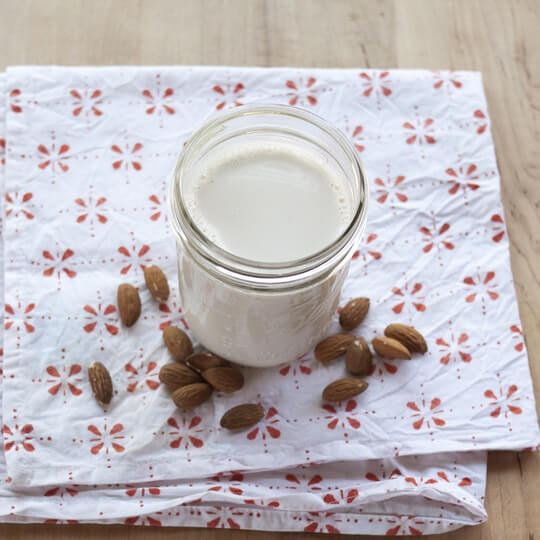Since 40% of the population is lactose intolerant, almond milk, and other milk alternatives, have become incredibly popular.
If you like the store bought kind, you’ll LOVE real, homemade almond milk.
Making almond milk is actually an incredibly old process.
The process essentially involves soaking almonds in water overnight or for up to two days — the longer you soak the almonds, the creamier the milk will be. Drain and rinse the beans from their soaking water and grind them with fresh water. The resulting liquid, drained from the almond meal, is almond milk.
Real, fresh, very tasty almond milk. It’s a life-changing thing.
Homemade almond milk only lasts a few days in the fridge, so make just what you think you will drink in this time period. You could heat your almond milk on the stove to pasteurize it and extend the shelf-life, but this somewhat defeats the purpose of making it yourself. The process of grinding and straining the milk only takes a few minutes, so making smaller, more frequent batches doesn’t feel too labor-intensive to me.
Start with a ratio of 1 cup almonds to 2 cups water when making almond milk. This makes a milk that is roughly the consistency of 2% milk. If you’d like a thinner milk, use more water next time; for thicker milk, use less.
It can be made in both a blender and the food processor, good results with both. Overall, the milk made in the blender ever-so-slightly better: it has a silky texture and a subtly sweet flavor. Milk made in the food processor is a bit thicker and occasionally has some grit, and it has a more pronounced nutty flavor. Visually, you can’t tell the difference at all! If you have both a blender and a food processor, try making almond milk in both to see which one you prefer.
Homemade Almond Milk
Ingredients
1 cup raw almonds, preferably organic
2 cups water, plus more for soaking
Sweeteners like honey, sugar, agave syrup, or maple syrup, to taste, optional
Equipment
Bowls
Strainer
Measuring cup
Blender or food processor
Fine-mesh nut bag or cheese cloth
Instructions
Soak the almonds overnight or up to 2 days.
Place the almonds in a bowl and cover with about an inch of water. They will plump as they absorb water. Let stand on the counter, covered with a cloth, overnight, or refrigerate for up to 2 days. The longer the almonds soak, the creamier the almond milk.
Drain and rinse the almonds.
Drain the almonds from their soaking water and rinse them thoroughly under cool running water. At this point, the almonds should feel a little squishy if you pinch them. (It’s best to discard the soaking water because it contains phytic acid, which inhibits the body’s ability to absorb nutrients.)
Combine the almonds and water in a blender.
Place the almonds in the blender and cover with 2 cups of water.
Blend at the highest speed for 2 minutes.Â
Pulse the blender a few times to break up the almonds, then blend continuously for two minutes. The almonds should be broken down into a very fine meal and the water should be white and opaque. (If using a food processor, process for 4 minutes total, pausing to scrape down the sides halfway through.)
Strain the almonds.
Line the strainer with either the opened nut bag or cheese cloth, and place over a measuring cup. Pour the almond mixture into the strainer.
Press all the almond milk from the almond meal.
Gather the nut bag or cheese cloth around the almond meal and twist close. Squeeze and press with clean hands to extract as much almond milk as possible. You should get about 2 cups. (See Recipe Note for what to do with the leftover almond meal.)
Sweeten to taste.
Taste the almond milk, and if a sweeter drink is desired, add sweetener to taste.
Refrigerate almond milk.
Store the almond milk in sealed containers in the fridge for up to two days.
Recipe Notes
Using the leftover almond meal:Â The leftover almond meal can be added to oatmeal, smoothies, and muffins as it is. You can also spread it out on a baking sheet and bake it in a low oven until completely dry (2 to 3 hours). Dry almond meal can be kept frozen for several months and used in baked goods.

Source:Â http://www.thekitchn.com/how-to-make-almond-milk-at-home-cooking-lessons-from-the-kitchn-189996


